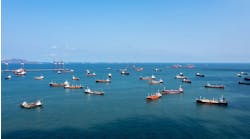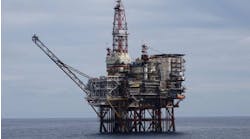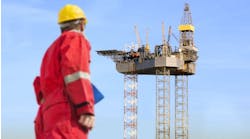Judy Maksoud • Houston
Americas
The Agência Nacional do Petróleo (ANP) will launch Brazil Round 6 in Rio de Janeiro in August. A public presentation of the blocks on offer was scheduled for January, followed by the publication of the initial tender protocol and release of the data packages in February.
The initial tender protocol lists the sectors and blocks for bidding, a description of the conditions for participating in the round, the minimum signature bonuses, and the duration of the exploration phase.
Blocks in 29 sectors of the country's 12 sedimentary basins will be offered in this round, which encompasses mature onshore basins, main producing basins, and frontier basins. Average shallow-water block size is 180 sq km. Deepwater blocks average 720 sq km.
Offshore basins include Pelotas, Campos, Santos, Espírito Santo, Jequitinhonha, Cam-amu, Sergipe-Alagoas, Barreirinhas, Pará-Maranhão, and Foz do Amazonas.
Information on the ANP bidding rounds, including the maps of the areas under offer in Brazil Round 6 and the detailed schedule for the round, is available at http://www.Brasil-Rounds.gov.br.
Africa
The Production Sharing Contract Area B joint venture has declared the Chinguetti oil field offshore Mauritania commercial. The decision is a key milestone toward making a final investment decision and beginning to award contracts by mid-2004.
Operator Woodside said first oil is likely by late 2005 or early 2006.
Meanwhile, Dana Petroleum began exploration drilling off Mauritania with the deepwater Pelican-1 well on block 7, 150 km north of Chinguetti.
null
Pelican-1 is the first step in an extensive exploration program. Dana has acquired seismic data across blocks 1, 7, and 8.
Near the middle of the continent, another well has hit oil off Gabon. The wildcat well Ebouri No. 1, 11 km northwest of the Etame field, and its associated horizontal sidetrack were successfully taken to total depth, delineating an oil accumulation on the eastern flank of the prospect. Either a second well or a further sidetrack from EBO-1 will be necessary to fully delineate the Ebouri prospect.
If the prospect contains commercial quantities of oil, it will probably be tied back this year to the existing FPSO.
Vaalco Gabon Etame Inc. operates the Etame field.
Early this year, a group led by Afrex Ltd. signed a memorandum of understanding (MOU) with the government of Eritrea for the 11,550-sq-km Massawa block in the Red Sea.
The MOU covers the principal terms negotiated during 2003 with the government for a production sharing contract (PSC) over the Massawa block, located solely within Eritrean territorial waters. Subject to finalization of the PSC over the next five months, the joint venture has exclusive exploration rights in the Massawa block for up to seven years.
The Massawa block lies in a Tertiary-aged salt basin of the southern Red Sea. North of the Massawa block, offshore Egypt, a large number of commercial oil and gas fields have been discovered over the past 20 years. Within the Massawa block itself, surface oil seeps have been identified near the Dahlak Islands.
The exploration program in the Massawa block will begin with re-mapping of the existing seismic data and seismic reprocessing, followed by the acquisition of new seismic data.
Afrex Ltd. operates the block with 40% interest. Pancontinental Oil & Gas NL and Hardman Resources Ltd. each hold 30%.
Mediterranean
Libya is planning a licensing round for early 2004. With the United Nations lifting sanctions in September 2003, the way is open for increased foreign investment.
US companies will not be allowed to participate in the licensing. US sanctions put in place in 1982 and toughened four years later prohibit US importation of Libyan crude and direct trade with the country by US companies.
Algeria's fourth bidding round saw the award of five of seven blocks on offer. There were no bids for either of the two offshore blocks, which will likely be offered again in the next bidding round.
Middle East
The first of three jackets for the wellhead platforms required in phases six through eight of the Statoil-operated South Pars development off Iran was installed early in January.
The jacket, weighing 1,500 metric tons, was deployed in a depth of 65 m in the Per-sian Gulf.
The job of attaching the jacket to the seabed with four 180-m piles began about two weeks later. According to the schedule, drilling was to begin on the first wells in early February. The second jacket was set for load-out and transport about the same time.
Iran's Isoico secured the engineering, procurement, construction, and installation contract from Statoil to build the jackets. The work was done at the contractor's yard in the Iranian port of Bandar-e Abbas, with installation being handled by Dutch-based Stolt Heavy Lifting Engin-eering BV.
Topsides fabrication began around the beginning of the year under an engineering, procurement, and construction contract awarded to Iran's Sadra.
The first of the three wellhead platforms is to be ready for production in early 2005.
South Pars ranks as the world's largest offshore gas field and extends from the Iranian sector of the gulf into Qatari waters, where it is known as the North field.
UAE's Maritime Industrial Services Co. Ltd. Inc. recently expanded its MIS Sharjah Fabrication Yard, adding land and building a sheet pile jetty.
The addition has expanded the yard by 75,000 sq m. The new jetty is 400 m long and has a water depth of 8 m at low tide. MIS will be able to berth six drilling rigs concurrently for repairs at the new facility and is now large enough to accommodate an FPSO conversion project.
Following the expansion project, MIS is also planning to invest heavily over the next two to three years to expand the yard's infrastructure to double its current fabrication capacity. Expansion plans include two loadout and fabrication areas for topsides modules up to 10,000 tons and offshore platforms up to 100 m water depth, new fabrication buildings and fabrication areas for piping, tubulars, piles, stainless steel, and exotic metals. MIS also plans to add other general logistics and office infrastructure.
MIS will perform its first major project following yard expansion for National Drilling Co. The contract covers complete refurbishment and upgrading of the Al-Ittihad rig, which is scheduled to arrive at the new facility this month.
Asia-Pacific
To date, Australia's offshore petroleum resources mainly come from Bass Strait off the southeast tip of the continent and the North West Shelf off the northeast portion of Western Australia. In fact, the North West Shelf has become a leading supplier of LNG, and prospectivity off Western Australia is high.
Blocks in these two prospective areas will be part of this year's bidding round, along with blocks from the 2003 round that did not receive bids. Five offshore blocks were awarded in late January 2004 from the bidding round that closed Sept. 25, 2003. The blocks are off Western Australia, South Australia, and Tasmania.
null
Apache Corp.'s announcement in early January increasing reserves on the John Brookes field in Western Australia's Carnarvon basin might bring even more interest to the region. Apache's second appraisal well led total gross recoverable reserves to be revised upward from 400 bcf to 800 bcf.
Woodside Energy Ltd.'s deepwater Enfield development in the same area is getting into gear with an award to FMC Technologies Inc. to supply subsea systems and related equipment. The agreement includes 13 subsea trees, production controls, and associated systems. FMC Technologies also will furnish technical services related to installation and startup.
Last January, Woodside tagged FMC Technologies as a preferred supplier of subsea production systems, the first agreement of its type in the region.
Vietnam saw a lot of activity at the close of 2003.
Truong Son Joint Operating Co. hit oil in block 46/02 in mid December. The find was on the Song Doc prospect, which is adjacent to Talisman-operated block PM-3 of the Malaysia-Vietnam Commercial Arrangement Area (PM-3 CAA). Song Doc-1X is the first exploration well since the block was awarded in December 2002.
Truong Son JOC is a joint operating company made of up PetroVietnam Exploration and Production Co. with 40% interest, Talisman (Vietnam 46/02) Ltd. with 30%, and Petronas Carigali Overseas Sdn. Bhd. with 30%.
The Cuu Long Joint Operating Co. also completed a successful exploratory well at the end of last year. The 15-1-ST-1X well in the SuTu Trang field in the southeast corner of block 15-1 showed positive results, and more activity will be seen in the area. CLJOC has already conducted a 3D seismic survey over 400 sq km of SuTu Trang.
While exploration continues on SuTu Trang, production is under way on SuTu Den. The CLJOC began production ahead of schedule from the SuTu Den field in block 15-1. The company plans to drill additional development and appraisal wells in the SuTu Den and SuTu Vang fields this year.
CLJOC is made up of ConocoPhillips with 23.25%, PetroVietnam Exploration and Production with 50%, Korean National Oil Corp. with 14.25%, SK Corp. with 9%, and Geopetrol with 3.5%.
Big news off New Zealand is the award of an exploration permit for the country's first deepwater exploration license. AWE New Zealand Pty Ltd., Stewart Petroleum Co. Ltd., and WM Petroleum Ltd. partnered on the bid for the largest of five blocks, covering a 12,000-sq-km area where the Tui discovery was made in 2002.
Twenty-three bids were received for the 17 blocks on offer in the 2003 offshore North Taranaki and onshore Taranaki bidding round that closed in October.
New Zealand has already begun preparations for a competitive petroleum exploration permit bidding round in 2004. The offer will cover a large portion of the offshore Northland basin over which a substantial data package is being compiled. The package will incorporate a revised understanding of the basin's near-shore potential by using recently released data obtained from the deepwater Wakanui-1 well, drilled off the continental shelf in 1999 by Conoco and partners.





